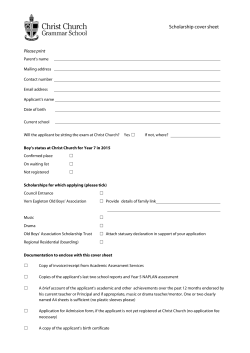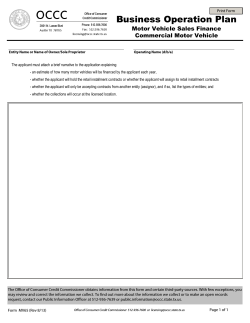
Proposed Changes to Environmental Criteria Manual
Proposed Changes to Environmental Criteria Manual (ECM) Section 1.6.9: Guidance for Compliance with Technical Requirements of the SOS Ordinance Mike Kelly City of Austin Watershed Protection Department Watershed Protection Ordinance Meeting June 13, 2014 Photo By Treye Rice www.treyerice.com/ Agenda • Proposed Environmental Criteria Manual (ECM) Changes for Section 1.6.9: SOS Ordinance Technical Requirements (90 minutes) • Break (10 minutes) • Update on New Option Proposed for Rain Gardens for Single‐Family Residential Subdivisions (15 minutes) • Next steps (5 minutes) Key Changes to ECM 1.6.9 1. Introducing Stormwater Control Measures 2. Emphasizing the load‐based approach 3. Pre‐approved controls in the Barton Springs Zone 4. Update data tables 5. Update the pollutants list 6. Implications of updates 7. Provide guidance for acceptance of alternative controls 8. Introduce the Stormwater Load Analysis Tool (SLAT) 1. Introducing Stormwater Control Measures • Terminology of “Best Management Practice” is broad and charged • For Austin’s engineered structural or non‐structural systems, use: Stormwater Control Measure (SCM) Photo: Knox County Conservation District 2. Emphasizing the Load-Based Approach • Updating the calculation procedure • Removal efficiency Effluent concentration • No prescribed water quality volume Example site with treatment trains and calculation variables 2. Emphasizing the Load-Based Approach Proposed Calculation Procedure 3. Pre-Approved Controls in Barton Springs Zone 4. Update Data Tables Updated Table 1-9 Impervious Cover, IC (%) Runoff‐ Rainfall Ratio, Rv Depression Storage, Sd (in) Annual Number of Runoff Events, θ Annual Runoff, V (in/yr) 0 0.064 0.218 46.0 1.18 10 0.136 0.180 50.6 2.76 20 0.208 0.148 54.8 4.55 30 0.279 0.122 58.5 6.54 40 0.351 0.100 61.8 8.67 50 0.423 0.082 64.6 10.9 60 0.494 0.068 66.9 13.2 70 0.566 0.056 69.0 15.6 80 0.637 0.046 70.7 18.0 90 0.709 0.038 72.2 20.5 100 0.781 0.031 73.4 22.9 Austin Total ‐‐ ‐‐ 79.3 31.7 Updated Table 1-10 Pollutant Concentration, CEx or CD Pollutant, i A B Site Contains Development (IC ≥ 0%) Site Completely Undeveloped (IC = 0%) COD mg/L = 38.9 + 66.6∙IC 38.9 E. coli CFU/100 mL 25000 8370 Pb mg/L = 0.00428∙exp(2.42∙IC) 0.00428 TN mg/L 2.22 1.19 TP mg/L 0.396 0.124 TSS mg/L 166 166 Zn mg/L = 0.0236∙exp(2.18∙IC) 0.0236 4. Update Data Tables New Table 1-11: Effluent Concentrations for Approved SCMs Ceff Pollutant COD EC Unit Infiltration Field Retention Basin Rainwater Harvesting Sedimentation/ Filtration Approved Alternative SCM 38.90 43.79 43.79 22.40 Applicant Provided 8370. 11070 11070 4895 Applicant Provided Non‐Infiltrated Fraction Infiltrated Fraction = min (CD,COD, Ceff‐1,COD) CFU/100 = min (CD,Ecoli, Ceff‐1,Ecoli) mL mg/L Pb mg/L =min (CD,Pb, Ceff‐1,Pb) 0.00428 .00831 .00831 .00574 Applicant Provided TN mg/L = min (CD,TN, Ceff‐1,TN) 1.19 1.42 1.42 1.07 Applicant Provided TP mg/L = min (CD,TP, Ceff‐1,TP) 0.124 0.224 0.224 .0990 Applicant Provided TSS mg/L = min (CD,TSS, Ceff‐1,TSS) 166 134 134 20.6 Applicant Provided Zn mg/L = min (CD,Zn, Ceff‐1,Zn) 0.0236 .0453 .0453 .0230 Applicant Provided 4. Update Data Tables New Table 1-12: Bypass Concentrations SCM 1 Bypass Concentration, Cby,1 Pollutant Unit Offline Control Online Control SCM 2 Bypass Concentration, Cby,2 COD mg/L = exp[4.493‐0.510(WQV)] = exp[4.916‐0.545(WQV)] = Ceff‐1,Table 1‐11 EC CFU/100 mL = exp[10.18‐0.465(WQV)] = exp[10.79‐0.624(WQV)] = Ceff‐1,Table 1‐11 Pb mg/L = 0.001∙exp[2.882‐ 0.489(WQV)] = 0.001∙exp[3.522‐ 0.529(WQV)] = Ceff‐1,Table 1‐11 TN mg/L = exp[0.957‐0.267(WQV)] = exp[1.322‐0.236(WQV)] = Ceff‐1,Table 1‐11 TP mg/L = exp[‐0.613‐0.469(WQV)] = exp[‐0.223‐0.400(WQV)] = Ceff‐1,Table 1‐11 TSS mg/L = exp[5.290‐0.934(WQV)] = exp[5.862‐0.765 (WQV)] = Ceff‐1,Table 1‐11 Zn mg/L = 0.001∙exp[4.610‐ 0.442(WQV)] = 0.001∙exp[5.200‐ 0.531(WQV)] = Ceff‐1,Table 1‐11 5. Update the Pollutants List (Pollutants for load calculations only) NEW LIST OLD LIST E. coli [added1] Fecal Coliform [deleted1] Fecal Streptococci [deleted1] Chemical Oxygen Demand Chemical Oxygen Demand Total Lead Total Lead Total Nitrogen Total Nitrogen Total Phosphorus Total Phosphorus Total Suspended Solids Total Suspended Solids Total Zinc [substitute] Cadmium [substituted] Biochemical Oxygen Demand [deleted1] Total Organic Carbon [deleted2] 1. 2. Code already changed Will require a code change 6. Implications of Updates 6. Application to Random Example Sites Site ID 1 2 3 4 5 6 7 8 9 10 11 12 Site Name Austin Waldorf School McMeans Store Muhich Office Warehouse Hilltop Park Dick Nichols District Park Heights at Loma Vista Phase 1 ‐ Pond 1 Heights at Loma Vista Phase 1 ‐ Pond 2 Oak Hill Branch Library HEB #23 at William Cannon/Brodie The Shops at Arbor Trails (Costco) Williamson Pointe Office Warehouse Parkway Village Costco at William Cannon & MoPac Drainage Area = 83.4 Ac Drainage Area Impervious Cover = 49.6% Drawdown Time = 60 hrs Has Splitter HEB at Brodie & William Cannon Drainage Area = 12.0 Ac Drainage Area Impervious Cover = 70.8% Drawdown Time = 71 hrs Has Splitter Analysis from SLAT Output 7. Alternative Controls • Alternative controls allowed • Applicant provides effluent concentrations from accepted testing protocol – – – – ABET approved university study Peer‐reviewed journal article Washington State TAPE protocol Technology Acceptance Reciprocity Partnership (TARP) protocol • Must still prove that effluent pollutant loads meet non‐degradation requirements 8. Introducing SLAT • • • Stormwater Load Analysis Tool for simple treatment trains Advanced design or stormwater routing would require engineering analysis (eg. SWMM) Open SLAT SLAT Screenshots Original Option Proposed for Rain Gardens for Single-Family Residential Subdivisions • Proposed in April 4, 2014 WPO meeting: 1. 2. 3. 4. 5. City of Austin to inspect & provide functional maintenance Homeowners may supplement maintenance, add additional native landscaping Must be located in the right‐of‐way, dedicated common area, or within a drainage easement that is accessible by standard maintenance equipment from the right‐of‐way Must treat clusters of single‐family residences (i.e., not individual lots) Cannot be located in backyards or fenced‐in yards • Moving forward with this option. • And offering a second option (see next slide) New, Additional Option for Rain Gardens for Single-Family Residential Subdivisions • Will draft pre‐July 14 ECM stakeholder meeting: 1. Private owner to provide maintenance 2. The City of Austin will inspect every 3 years—and potentially later on an as‐needed, complaint‐basis 3. OK to install on individual single‐family lots 4. Cannot be located in backyards 5. Must verify at point‐of‐sale of property that exist and are in good working order (like septic systems); provide literature re: maintenance • Will schedule stakeholder brainstorming session • Pilot: Want this to go well; good design and installation will be critical WPO Phase 2 Schedule, 2014 Phase 2 Kickoff Jan. 22 Perviousness: Introduction Feb. 21 Perviousness: Porous Pavement (part 1) Mar.07 Porous Pavement (part 2), Artificial Turf & Mar.21 Rainwater Harvesting Rain Gardens for Single‐Family Residential Apr. 04 Beneficial Use of Stormwater: Potential Policy Approaches Introduction/National Examples Apr. 18 Beneficial Use of Stormwater: Follow‐Up Discussion May 30 New Criteria for SOS Ordinance Compliance/ECM 1.6.9 June 13 RSMP‐Plus (Regional Stormwater Mgmt. Program) July 11 or 25? Next Steps TBD/Fall Contact Information Mike Kelly Watershed Protection Department City of Austin (512) 974‐6591 mike.kelly@austintexas.gov http://austintexas.gov/department/watershed‐protection‐ordinance
© Copyright 2025










